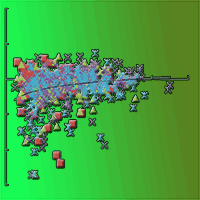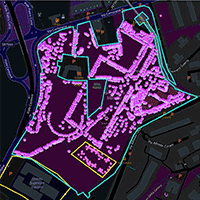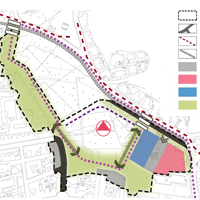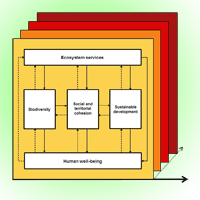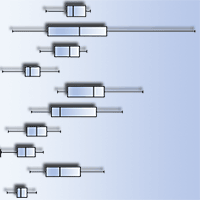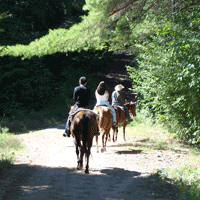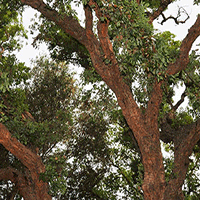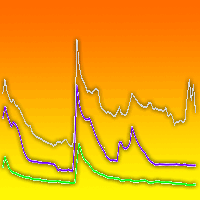Microclimate regulating functions of urban trees and their associations with environmental factors and tree-growth characteristics are important for management and ecological evaluations. In this study, a total of 637 trees distributed in the Changchun urban region (ca. 400 km2, northeastern China) were sampled in four different types of urban forests (AF: affiliated forests; RF: roadside forests; LF: landscape and relaxation forests; EF: ecological welfare forests). Tree growth-related parameters and environmental factors (inside and outside the forest) were simultaneously measured, and location-dependent differences in shading, cooling and humidifying effects were assessed, along with their associations with the measured variables. We found that urban forests in Changchun reduced the incident sunlight by 74-86% and increased air relative humidity by 3-7%, on average. Air, soil, and upper-canopy temperatures were decreased approximately by 3 °C, <1 °C and 1 °C, respectively, showing a 3-dimensional cooling effect of urban forests on both air and soil. Shading, cooling and humidifying effects significantly differed among the four forest types, with AF stands showing the highest comprehensive scores for all the microclimate regulation functions. Regression analyses and redundancy analysis revealed that urban forests had much stronger effect in terms of microclimate regulation at sunny days with high temperature, and low air humidity. In general, stands with larger trees showed the higher regulating functions, regardless of the stand structure and composition. The results of this study may help urban forest management and planning aimed at maximizing their ecological services.
Keywords
, , ,
Citation
Wang W, Wang H, Xiao L, He X, Zhou W, Wang Q, Wei C (2018). Microclimate regulating functions of urban forests in Changchun City (north-east China) and their associations with different factors. iForest 11: 140-147. - doi: 10.3832/ifor2466-010
Academic Editor
Raffaele Lafortezza
Paper history
Received: Apr 20, 2017
Accepted: Nov 21, 2017
First online: Feb 07, 2018
Publication Date: Feb 28, 2018
Publication Time: 2.60 months
© SISEF - The Italian Society of Silviculture and Forest Ecology 2018
Open Access
This article is distributed under the terms of the Creative Commons Attribution-Non Commercial 4.0 International (https://creativecommons.org/licenses/by-nc/4.0/), which permits unrestricted use, distribution, and reproduction in any medium, provided you give appropriate credit to the original author(s) and the source, provide a link to the Creative Commons license, and indicate if changes were made.

Breakdown by View Type
(Waiting for server response...)
Article Usage
Total Article Views: 51205
(from publication date up to now)
Breakdown by View Type
HTML Page Views: 42666
Abstract Page Views: 3710
PDF Downloads: 3735
Citation/Reference Downloads: 54
XML Downloads: 1040
Web Metrics
Days since publication: 2861
Overall contacts: 51205
Avg. contacts per week: 125.28
Article Citations
Article citations are based on data periodically collected from the Clarivate Web of Science web site
(last update: Mar 2025)
Total number of cites (since 2018): 22
Average cites per year: 2.75
Publication Metrics
by Dimensions ©
Articles citing this article
List of the papers citing this article based on CrossRef Cited-by.
(1)
Akinbode OM, Eludoyin AO, Fashae OA (2008)Temperature and relative humidity distributions in a medium-size administrative town in southwest Nigeria. Journal of environmental management 87: 95-105.
CrossRef |
Gscholar
(2)
Alexandri E, Jones P (2008)Temperature decreases in an urban canyon due to green walls and green roofs in diverse climates. Building and Environment 43: 480-493.
CrossRef |
Gscholar
(3)
Armson D, Stringer P, Ennos AR (2012)The effect of tree shade and grass on surface and global temperatures in an urban area. Urban Forestry and Urban Greening 11: 245-255.
CrossRef |
Gscholar
(4)
Arx GV, Dobbertin M, Rebetez M (2012)Spatio-temporal effects of forest canopy on understory microclimate in a long-term experiment in Switzerland. Agriculture and forest meteorology 166-167: 144-155.
CrossRef |
Gscholar
(5)
Bao CS, Lou JH, Zeng XY, Xiang ZS (2001)Effect of landscaping and greening on microclimate in Hangzhou city. Journal of Zhejiang University (Agriculture and Life Sciences) 27: 415-418.
Gscholar
(6)
Berry R, Livesley SJ, Aye L (2013)Tree canopy shade impacts on solar irradiance received by building walls and their surface temperature. Building and Environment 69: 91-100.
CrossRef |
Gscholar
(7)
Bowler DE, Buyung-Ali L, Knight TM, Pullin AS (2010)Urban greening to cool towns and cities: a systematic review of the empirical evidence. Landscape and urban planning 97: 147-155.
CrossRef |
Gscholar
(8)
Gao MR, Jia BQ, Wang C, Sun CH (2014)Relationship between urban forest canopy cover and heat island effect in Xiamen Island. Scientia Silvae Sinicae 50: 63-68.
Gscholar
(9)
Georgi NJ, Zafiriadis K (2006)The impact of park trees on microclimate in urban areas. Urban Ecosystems 9: 195-209.
CrossRef |
Gscholar
(10)
Giannico V, Lafortezza R, John R, Sanesi G, Pesola L, Chen JQ (2016)Estimating stand volume and above-ground biomass of urban forests using LiDAR. Remote Sensing 8: 339.
CrossRef |
Gscholar
(11)
Greene CS, Millward AA (2017)Getting closure: the role of urban forest canopy density in moderating summer surface temperatures in a large city. Urban Ecosystems 20: 141-156.
CrossRef |
Gscholar
(12)
Hamada S, Tanaka T, Ohta T (2013)Impacts of land use and topography on the cooling effect of green areas on surrounding urban areas. Urban Forestry and Urban Greening 12: 426-434.
CrossRef |
Gscholar
(13)
Hao XY, Lin YD, Wu XG, Wang J, Liang F, Liang J (2007)Vertical thermal characteristics analysis between different urban green land. Acta Ecologica Sinica 2: 685-692 [in Chinese].
CrossRef |
Gscholar
(14)
He XY, Liu CF, Chen W (2004)Discussion on urban forest classification. Chinese Journal of Ecology 23: 175-178. [in Chinese]
Online |
Gscholar
(15)
Hu YL, Wang SL, Yan SK (2006)Advances in the study of factors affecting soil microbial activity and community structure. Chinese Journal of Soil Science 37: 170-176 [in Chinese].
CrossRef |
Gscholar
(16)
Huang HX, Li JL, Huang LM (2008)Diurnal variation patterns of microclimate and their effects on human comfort degree in Nanjing City. Chinese Journal of Ecology 27: 601-606 [in Chinese].
CrossRef |
Gscholar
(17)
Imhoff ML, Zhang P, Wolfe RE, Bounoua L (2010)Remote sensing of the urban heat island effect across biomes in the continental USA. Remote Sensing of Environment 114: 504-513.
CrossRef |
Gscholar
(18)
Jim CY (2015)Thermal performance of climber green walls: effects of solar irradiance and orientation. Applied Energy 154: 631-643.
CrossRef |
Gscholar
(19)
Jonsson P (2004)Vegetation as an urban climate control in the subtropical city of Gaborone, Botswana. International Journal of Climatology 24: 1307-1322.
CrossRef |
Gscholar
(20)
Li YH, Wang JJ, Chen X, Sun JL, Zeng H (2011)Effects of green space vegetation canopy pattern on the microclimate in residential quarters of Shenzhen City. Chinese Journal of Applied Ecology 22: 343-349. [in Chinese]
CrossRef |
Gscholar
(21)
Liao R, Cui J, Zhuo CL, Gao SP (2012)Comparative study on the effect of 32 kinds of stereoscopic greening plants in Chengdu City. Journal of Jiangsu Agricultural Sciences 40: 178-181.
Gscholar
(22)
Lin ML, Chen QB, Deng XG (2010)Cooling, humidifying and shading effects of urban forests in Yangpu economic development zone. Chinese Journal of Tropical Agriculture 4: 15-19.
Gscholar
(23)
Lin YD, Han XM, Wu XG, Hao XY, Wang J, Liang F, Liang J, Wang ZH (2006)Ecological field characteristic of green land based on urban green space structure. Acta Ecologica Sinica 26: 3339-3346 [in Chinese].
CrossRef |
Gscholar
(24)
Liu JM, Li SH, Yang ZF (2008)Temperature and humidity effect of urban green spaces in Beijing in summer. Chinese Journal of Ecology 27: 1972-1978 [in Chinese].
Online |
Gscholar
(25)
Liu YH, Guo JP (2009)The research of NDVI-based urban green space landscape pattern and thermal environment. Progress in Geography 28: 798-804 [in Chinese].
Online |
Gscholar
(26)
Lu JL, Sen G, Wang Q, Ren ML, Pei ZX, Wei CH, Wang WJ (2016)Effect of urban tree species on soil physicochemical properties in Harbin city, Northeastern China, and afforestation implications. Bulletin of Botanical Research 7: 549-555 [in Chinese with English summary].
CrossRef |
Gscholar
(27)
Ma N, He XY, Shi XF, Chen W (2011)Evaluation of urban forest economic benefit based on i-Tree model. Chinese Journal of Ecology 4: 810-817 [in Chinese].
CrossRef |
Gscholar
(28)
Mariani L, Parisi SG, Cola G, Lafortezza R, Colangelo G, Sanesi G (2016)Climatological analysis of the mitigating effect of vegetation on the urban heat island of Milan, Italy. Science of the Total Environment 569-570: 762-773.
CrossRef |
Gscholar
(29)
Marziliano PA, Lafortezza R, Colangelo G, Davies C, Sanesi G (2013)Structural diversity and height growth models in urban forest plantations: a case-study in northern Italy. Urban Forestry and Urban Greening 12: 246-254.
CrossRef |
Gscholar
(30)
Panno A, Carrus G, Lafortezza R, Mariani L, Sanesi G (2017)Nature-based solutions to promote human resilience and wellbeing in cities during increasingly hot summers. Environmental Research 159: 249-256.
CrossRef |
Gscholar
(31)
Perini K, Ottelé M, Haas EM, Raiteri R (2013)Vertical greening systems, a process tree for green façades and living walls. Urban Ecosystems 16: 265-277.
CrossRef |
Gscholar
(32)
Pesola L, Cheng X, Sanesi G, Colangelo C, Elia M, Lafortezza R (2017)Linking above-ground biomass and biodiversity to stand development in urban forest areas: a case study in Northern Italy. Landscape and Urban Planning 157: 90-97.
CrossRef |
Gscholar
(33)
Qin YM, Liu K, Wang YJ (2006)Ecological functions of green land system in Xi’an. Chinese Journal of Ecology 25: 135-139. [in Chinese with English summary].
Online |
Gscholar
(34)
Ren ZB (2014)Multi-scale effects of urban forest on urban thermal environment: a study in Changchun. Ph.D. thesis, Northeast Institute of Geography and Agricultural Ecology, Chinese Academy of Sciences, Changchun, China, pp. 126 [in Chinese].
Online |
Gscholar
(35)
Shashua BL, Hoffman ME (2000)Vegetation as a climatic component in the design of an urban street: an empirical model for predicting the cooling effect of urban green areas with trees. Energy and Buildings 31: 221-235.
CrossRef |
Gscholar
(36)
Solecki WD, Rosenzweig C, Parshall L, Pope G, Clark M, Cox J, Wiencke M (2005)Mitigation of the heat island effect in urban New Jersey. Global Environmental Change Part B: Environmental Hazards 6: 39-49.
CrossRef |
Gscholar
(37)
Wang YF, Bakker F, Groot RD, Wortche H, Leemans R (2015)Effects of urban trees on local outdoor microclimate: synthesizing field measurements by numerical modelling. Urban Ecosystems 18: 1305-1331.
CrossRef |
Gscholar
(38)
Wang WJ, Lu JL, Du HJ, Wei CH, Wang HM, Fu YJ, He XY (2017a)Ranking thirteen tree species based on their impact on soil physiochemical properties, soil fertility, and carbon sequestration in Northeastern China. Forest Ecology and Management 404: 214-229.
CrossRef |
Gscholar
(39)
Wang WJ, Zhong ZL, Wang Q, Wang HM, Fu YJ, He XY (2017b)Glomalin contributed more to carbon, nutrients in deeper soils, and differently associated with climates and soil properties in vertical profiles. Scientific Reports 7: 13003.
CrossRef |
Gscholar
(40)
Wong NH, Yu C (2005)Study of green areas and urban heat island in a tropical city. Habitat International 29: 547-558.
CrossRef |
Gscholar
(41)
Wu F, Li SH, Liu JM (2007)The effects of greening none-greening square and lawn on temperature, humidity and human comfort. Acta Ecologica Sinica 27: 2964-2971 [in Chinese].
CrossRef |
Gscholar
(42)
Wu XG, Lin YD, Yan HB, Hao XY (2008)Correlation between ecological effect and structure characteristics of urban green areas. Chinese Journal of Eco-Agriculture 16: 1469-1473.
CrossRef |
Gscholar
(43)
Xu S, Chen W, He XY, Huang YQ, Gao JY, Zhao Y, Li B (2015)Research advance in effect of elevated CO
2 on eco-physiology of trees. Acta Ecologica Sinica 35: 2452-2460.
CrossRef |
Gscholar
(44)
Zhang D, Zheng HF, He XY, Ren ZB, Zhai C, Yu XY, Mao ZX, Wang PJ (2016)Effects of forest type and urbanization on species composition and diversity of urban forest in Changchun, Northeast China. Urban Ecosystems 19: 455-473.
CrossRef |
Gscholar
(45)
Zhang ML, Qin J, Hu YH (2008)Effects of temperature reduction and humidity increase of plant communities in Shanghai. Journal of Beijing Forestry University 30: 39-43. [in Chinese]
CrossRef |
Gscholar
(46)
Zhang Z (2007)Study on structure of road greening and the improvement of microclimate in Harbin. Master Thesis, Northeast Forestry University, Harbin, China, pp. 51. [in Chinese]
Online |
Gscholar
(47)
Zhang Z, Lv Y, Pan H (2013)Cooling and humidifying effect of plant communities in subtropical urban parks. Urban Forestry and Urban Greening 12: 323-329.
CrossRef |
Gscholar
(48)
Zheng J, Hu MJ, Guo YP (2008)Regulation and mechanism of light quality on plant photosynthesis. Chinese Journal of Applied Ecology 19: 1619-1624.
Online |
Gscholar
(49)
Zhao X (2008)Study on comprehensive benefits appraisal in residential green space. Master Thesis, Anhui Agricultural University, Hefei, China, pp. 46. [in Chinese]
CrossRef |
Gscholar
(50)
Zhou LC, Shi WY, Xue WJ, Wang TH (2005)Relationship between vegetation structure and the temperature and moisture in urban green spaces of Shanghai. Chinese Journal of Ecology 24: 1102-1105. [in Chinese]
CrossRef |
Gscholar
